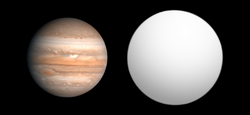Astronomy:HAT-P-2b
 Size comparison of HAT-P-2b with Jupiter. | |
| Discovery | |
|---|---|
| Discovered by | HATNet Project[1] |
| Discovery date | 2007-05-01[2] |
| Transit | |
| Designations | |
| HD 147506 b, Magor | |
| Orbital characteristics[4] | |
| 0.06880+0.00065 −0.00070 astronomical unit|AU | |
| Eccentricity | 0.50833+0.00082 −0.00075 |
| Orbital period | 5.6334754±0.0000026 d |
| Inclination | 86.72°+1.1° −0.87° |
| astron|astron|helion}} | 2455289.4721±0.0038[3] |
| 186.96°+0.87° −0.88° | |
| Semi-amplitude | 938.1+10.0 −9.9 m/s |
| Star | HD 147506 |
| Physical characteristics[4] | |
| Mean radius | 1.157+0.073 −0.063 RJ |
| Mass | 8.70+0.19 −0.20 Jupiter mass |
| Mean density | 7.3+1.4 −1.1 g/cm3 |
| 162±27 m/s² | |
| Physics | 1540±30 K[5] |
HAT-P-2b is an extrasolar planet detected by the HATNet Project in May 2007. It orbits a class F star HAT-P-2, (bigger and hotter than the Sun), located about 420 light-years away in the constellation Hercules.
The planet is officially named Magor. The name was selected in the NameExoWorlds campaign by Hungary, during the 100th anniversary of the International Astronomical Union. Magor was a legendary ancestor of the Magyar people and the Hungarian nation, and brother of Hunor (name of the star HAT-P-2).[6][7]
Physical properties
The planet's mass has been estimated to be 8.7 times that of Jupiter, while its diameter is 1.157 times Jupiter's.[4] Its small size, despite the bloating of the planet's atmosphere, is caused by the strong gravity of the planet. The planetary atmosphere has indeed the smallest scale height, equal to 26km, among exoplanets with measurable atmospheres as of 2021.[8]
This indicates its mean density is twice that of Earth and its surface gravity approximately 24 times that of Earth, almost equal to the Sun.
In addition to heat from its primary star, tidal heating is thought to have played a significant role in this planet's evolution.[9]
Orbit
The planetary orbital period is 5 days 15 hours, and its inclination is such that it crosses directly in front of the star as viewed from Earth.[1][2] The orbit is very eccentric, ranging from 4.90 million to 15.36 million miles from the star.[2]
As of August 2008, the most recent calculation of HAT-P-2b's Rossiter–McLaughlin effect and so spin-orbit angle was that of Winn in 2007 but Loeillet has in 2008 disputed it.[10][11] For Winn, this is +1 ± 13 degrees.[12] The study in 2012 determined the planetary orbit is probably aligned with the equatorial plane of the star, with misalignment equal to 9±10°.[13]
Other planets in the system
It has been suggested that there is a second outer planet perturbing HAT-P-2b.[2] In 2023, the presence of a second planet, HAT-P-2c, was confirmed.[14]
References
- ↑ Jump up to: 1.0 1.1 Bakos, G. Á. et al. (2007). "HD 147506b: A Supermassive Planet in an Eccentric Orbit Transiting a Bright Star". The Astrophysical Journal 670 (1): 826–832. doi:10.1086/521866. Bibcode: 2007ApJ...670..826B.
- ↑ Jump up to: 2.0 2.1 2.2 2.3 Aguilar, David A.; Pulliam, Christine (2007-05-01). "Astronomers find super-massive planet" (Press release). Harvard-Smithsonian Center for Astrophysics. Retrieved 2019-01-05.
- ↑ Lewis, Nikole K. et al. (2013). "Orbital Phase Variations of the Eccentric Giant Planet HAT-P-2b". The Astrophysical Journal 766 (2): 95. doi:10.1088/0004-637X/766/2/95. Bibcode: 2013ApJ...766...95L.
- ↑ Jump up to: 4.0 4.1 4.2 Bonomo, A. S. et al. (2017). "The GAPS Programme with HARPS-N at TNG . XIV. Investigating giant planet migration history via improved eccentricity and mass determination for 231 transiting planets". Astronomy and Astrophysics 602 (107): A107. doi:10.1051/0004-6361/201629882. Bibcode: 2017A&A...602A.107B.
- ↑ Pál, András et al. (2010). "Refined stellar, orbital and planetary parameters of the eccentric HAT-P-2 planetary system". Monthly Notices of the Royal Astronomical Society 401 (4): 2665–2674. doi:10.1111/j.1365-2966.2009.15849.x. Bibcode: 2010MNRAS.401.2665P. https://academic.oup.com/mnras/article/401/4/2665/1133237.
- ↑ "Approved names" (in en). http://www.nameexoworlds.iau.org/final-results.
- ↑ "International Astronomical Union | IAU". https://www.iau.org/news/pressreleases/detail/iau1912/.
- ↑ Baxter, Claire; Désert, Jean-Michel; Tsai, Shang-Min; Todorov, Kamen O.; Bean, Jacob L.; Deming, Drake; Parmentier, Vivien; Fortney, Jonathan J. et al. (2021), "Evidence for disequilibrium chemistry from vertical mixing in hot Jupiter atmospheres", Astronomy & Astrophysics 648: A127, doi:10.1051/0004-6361/202039708
- ↑ Jackson, Brian et al. (2008). "Tidal Heating of Extra-Solar Planets". Astrophysical Journal 681 (2): 1631. doi:10.1086/587641. Bibcode: 2008ApJ...681.1631J.
- ↑ Joshua N. Winn (2008). "Measuring accurate transit parameters". Proceedings of the International Astronomical Union 4: 99–109. doi:10.1017/S174392130802629X. Bibcode: 2009IAUS..253...99W.
- ↑ Loeillet, B. et al. (2008). "Refined parameters and spectroscopic transit of the super-massive planet HD 147506b". Astronomy and Astrophysics 481 (2): 529–533. doi:10.1051/0004-6361:20078167. Bibcode: 2008A&A...481..529L.
- ↑ Winn (2007). "Spin-Orbit Alignment for the Eccentric Exoplanet HD 147506b". Astrophysical Journal Letters 665 (2): L167. doi:10.1086/521362. Bibcode: 2007ApJ...665L.167W.
- ↑ Albrecht, Simon; Winn, Joshua N.; Johnson, John A.; Howard, Andrew W.; Marcy, Geoffrey W.; Butler, R. Paul; Arriagada, Pamela; Crane, Jeffrey D. et al. (2012), "Obliquities of Hot Jupiter Host Stars: Evidence for Tidal Interactions and Primordial Misalignments", The Astrophysical Journal 757 (1): 18, doi:10.1088/0004-637X/757/1/18, Bibcode: 2012ApJ...757...18A
- ↑ de Beurs, Zoë L. et al. (October 2023). "Revisiting Orbital Evolution in HAT-P-2 b and Confirmation of HAT-P-2 c". The Astronomical Journal 166 (4): 136. doi:10.3847/1538-3881/acedf1. Bibcode: 2023AJ....166..136D.
External links
Coordinates: ![]() 16h 20m 36s, +41° 02′ 53″
16h 20m 36s, +41° 02′ 53″
 |

